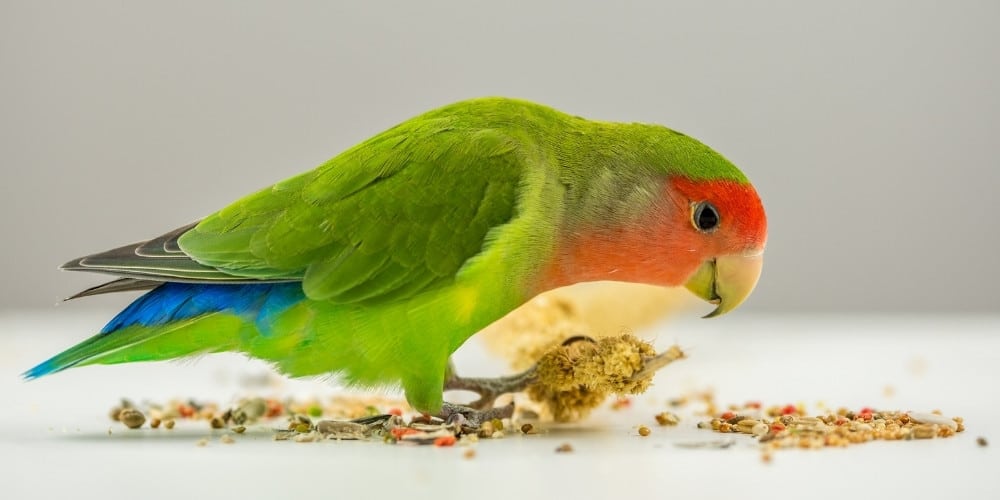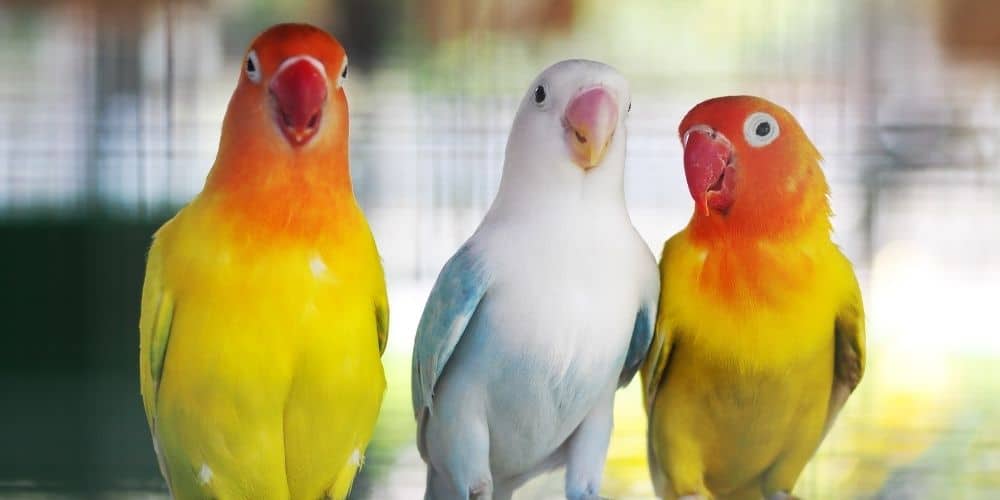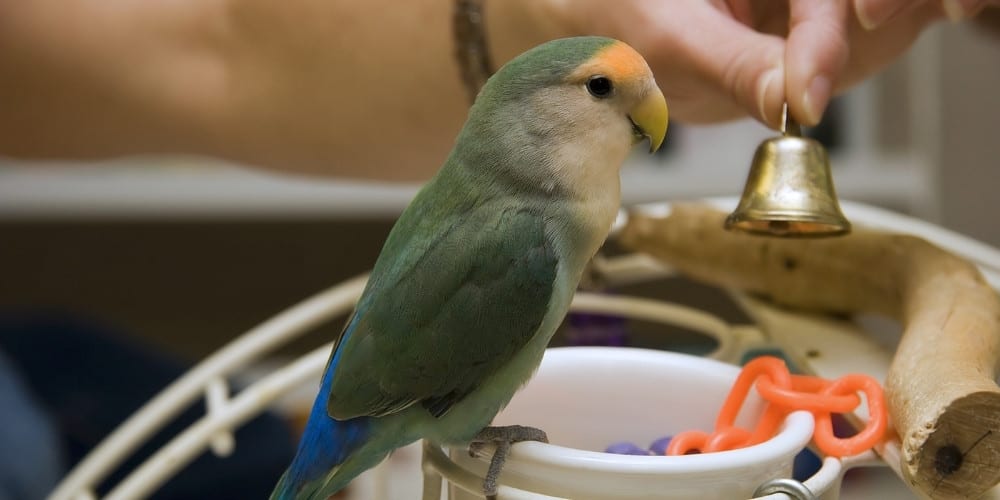The cheerful colors of lovebird parrots make experts and novices alike fall in love with them, and in their pairs, the adorable displays of affection and sweet serenading put many human relationships to shame.
But what are these lovey-dovey birds like as day-to-day pets?
Are lovebirds good pets? Lovebirds make wonderfully loyal pets for dedicated beginners that can devote many hours of social interaction to them – more so with single lovebirds as lovebird pairs will forge their own strong bonds. Their low noise level and keen, intelligent nature make them a joy to train and care for.
Lovebird parrots have a lot to offer in the way of companionship and will enjoy learning tricks and behaviors in a bid to spend quality time with you.
Whether you want a single bird as a pet or a lovebird pair, the following guide will help you make an informed decision.
Lovebird Facts
You may have heard their sweet calls and admired their bright, sunny plumage, but how much do you really know about lovebirds?
Let’s delve into their care needs, their cost, what makes them tick, and more…
Lovebird Size & Appearance
Lovebirds range from 5-6.5 inches long with stout bodies and short, blunt tail feathers.
These pint-sized birds come in a blend of bright colors that typically include orange, green, yellow, and red.
Lovebirds also have distinctive white eye rings and accents around their beaks and may have lighter or darker face patches depending on the species.
Lovebird Temperament & Personality
Lovebirds are known to have silly, playful personalities once they feel secure with owners, and they often have bundles of energy that belie their size.
They can have a feisty, grumpy side, however, and their well-being hinges on how much social interaction you afford them.
Native Region & Habitat
Lovebirds are native to mainland Africa, except for the Madagascar or “Grey-headed” lovebird.
Lovebirds are found mainly in north-east Tanzania and gather in small flocks near bodies of water, savannas, and woodland areas.
Lovebird Intelligence & Trainability
How Smart Are Lovebirds?
Lovebirds are naturally inquisitive and are known to pick up on visual and vocal cues quite quickly.
They are considered by many owners to have similar intelligence levels and demands to dogs and can be trained with similar success with daily effort.
Lovebird Sounds & Vocalizations
Lovebirds regularly communicate in repetitive whistles and chirps throughout the day and tend to be more vocal at dawn and dusk.
Below are the common lovebird vocalizations and their meanings:
- Singing – Lovebirds will sing in light, joyful tones like the pre-dawn chorus of birdsong, and this simply tells you that they are at peace and secure with their surroundings.
- Chirping – Chirping is directed at you or their mate and is done with enthusiasm and eye contact. Your lovebird will deliver short, high-pitched chirps and squeaks as if they were talking to you.
- Screaming or Shrieking – A lovebird’s “scream” is generally more gentle on the ears than other parrots and will sound like a shrill, repetitive alarm call. This usually denotes nerves or uncertainty.
- Clicking – Clicking their tongue is often a sign they desire your attention, though they may also do this when they are playing on their own and having fun.
Lovebird Care

Ideal Pet Lovebird Diet
Lovebirds will thrive on a varied diet of pellets, fresh fruit and vegetables, seeds, and water.
(In this article, you’ll find a complete breakdown of the recommended diet for parrots, including dangerous foods to avoid.)
However, the main bulk of their feed should focus on pellet formula, making up around 75-80% of their daily diet (or ¼ cup/2 ounces per day).
Pellets are the best way to introduce essential nutrients while preventing them from becoming too picky with individual fruit and vegetable offerings.
Seeds should make up no more than 25% (a level tablespoon) of their daily feed to prevent nutrient deficiency.
Housing Requirements
Rectangular cages (measuring about 24” tall x 36” long x 24” wide) allow two lovebirds to comfortably fly about.
If you go bigger, just ensure the bar spacing is no wider than ½ of an inch.
In the cage should be a minimum of two 1-1½ inch diameter perches per bird – a hardwood perch that can endure chews and a therapeutic “conditioning” perch to keep nails and beaks trim.
Exercise
Swing perches are a good way to encourage exercise in your lovebird, but the best way of keeping them active is letting them outside their cage for free flight and exploration.
Provide a jungle gym so they have outside cage perches and climbing material. Don’t forget to take them outdoors to spread their wings too.
Just be sure safety comes first, and either have a secure outdoor flight cage or use a parrot harness, like this adjustable, lightweight harness on Amazon.
Stimulation
Feed your lovebirds’ curious minds by keeping plenty of toys in their cage that engage the senses.
Things like swings for the joy of movement, wooden and acrylic chew toys to work out their beak, and colorful paper shreds for them to manipulate and (as pairs) make nests with are ideal.
Lovebird Price
Prices for lovebirds can range between $40-$200 depending on whether they have been hand-reared or parent-fed.
Rescue and pet store birds tend to be more affordable than prices set by private breeders who may have rarer colors available.
Cages cost between $150-$200.
When you factor in the ongoing costs of keeping a lovebird, such as toys, food supplies, and vet bills (dependent on location), this adds up to between $180 and $400 annually.
Lovebird Lifespan
Lovebirds typically live between 5-15 years in the wild, though they can live up to 20 years or more in captivity with proper care and nutrition.
Lovebird Interesting Facts
- Lovebirds are seen as the inspiration behind Valentine’s Day. A 14th-century poem by Geoffrey Chaucer named “Parliament of Foules” mentions two birds displaying the behaviors of human love during the religious celebration of Saint Valentine’s day.
- They can exhibit symptoms of depression if they are neglected by or lose their mate, experiencing low appetite, self-harm (feather-plucking), and appearing generally ill.
- Some species are androgynous. Only three of the nine species of lovebirds have characteristics that distinguish the males from the females.
- Many feral lovebirds living in Texas and Arizona make their home inside cacti, tree cavities, and even building crevices.
Types of Lovebirds

There are nine different species of lovebirds, and those most commonly kept as pets are the peach-faced lovebird, the Fischer’s lovebird, and the masked lovebird.
Which Type of Lovebird Makes the Best Pet?
According to licensed veterinary technician Ryan Corrigan, peach-faced lovebirds tend to be the least aggressive species, so this may make them the most appropriate type to have in a home with young children and for newbie keepers.
Fischer’s lovebirds are considered to be quite shy compared to the more outgoing peach-faced type.
Also, male lovebirds are known to be tamer than females, who can exhibit greater aggression once they approach sexual maturity (around 10 months old).
Do Lovebirds Need To Be in Pairs?
It’s a common misconception that lovebirds need to be paired up due to their strong flocking instinct.
The fact is, they can thrive equally well alone or as a pair, so long as they are afforded regular communication and quality time with either their feathered or human mate.
Can You Have a Single Lovebird?
Certainly, but you must be prepared to dedicate a minimum of 4 hours interaction with them per day.
You must decide whether a single lovebird fits in with your lifestyle because limited attention from you can result in isolation and depression for your pet.
Do Lovebirds Pair for Life?
Wild lovebirds organize themselves in pairs within their flock and form life-long bonds together, feeding, preening, and protecting each other from outside aggressors.
Captive lovebird pairs exhibit these same qualities and form stronger bonds with each other than with their human companion.
How Long Does It Take for Lovebirds To Bond Together?
If kept as pairs right from the start, a strong bond is likely to form quickly, but if you are introducing a new lovebird to your existing bird, this may take several weeks or months.
When introducing a second lovebird to your pet, you must do so slowly and with great care, because lovebirds can kill each other if there is lingering territoriality or jealousy.
You’ll find a helpful guide on introducing new birds here.
What Do You Do If One Lovebird Dies?
Firstly, hold off from getting another lovebird.
Your pet needs to process their grief in a similar way to humans, so you need to do two things once one of your lovebirds dies:
- Shower them with attention – you will both be grieving in the days and weeks that follow, so boost your lovebird and yourself by praising them and spending more one-on-one time with them than ever before (if they are receptive to this).
- Create a new routine – acclimatize your lone lovebird to a new routine to help them focus on their environment instead of what they have lost. Introduce new toys to their cage and have guests socialize with them more. Over time they will fall into a comfortable new pattern.
Why Are They Called Lovebirds? Do They Really Kiss?
They are named lovebirds because they form such strong attachments to their mate, whether this is another lovebird or human companion.
While two lovebirds may appear to be “kissing” each other, they are actually grooming each other’s beaks to keep them clean.
This is a form of affection to lovebirds, so it’s little wonder it appears like a romantic gesture to us!
Can Lovebirds Talk?
Lovebirds cannot talk in the sense of repeating distinct words like larger parrots.
However, lovebirds can be trained to mimic sounds made by their owners, such as kissing or laughing noises, and learn to “answer” owners by repeating tones and sounds given to them in certain contexts.
For example, saying “Bye-Bye” over long periods can result in “cheep-cheep” replies in a similar tone, and over time they may grow to associate the light turning off with this farewell sound.
Do Lovebirds Like Music?
Lovebirds find music pleasant if it serves the function of interacting with you, but don’t expect them to head bob or move along with you.
Professor of psychology at Cornell University, Dr. Timothy J. DeVoogd, says that:
Because bird song sounds musical to human ears, odds are that similar human music will sound song-like to some birds.
This may explain why lovebirds may not detect the beat like cockatoos seem to.
How Do You Bond With Lovebirds?
Always speak in gentle, soothing tones and sing to lovebirds from a young age.
As they become more comfortable around you, give them as much face-to-face interaction as possible throughout the day and praise them often.
As they grow older and more lively, start teaching them simple tricks (discover three easy tricks here) and persist daily.
Whether they pick up on them quickly or take months to learn, spending time with your lovebird is the key and will strengthen your bond.
Do Lovebirds Like To Cuddle With You?
Once they feel comfortable, single lovebirds may begin bowing their head in anticipation of head scratches and sidle close to you.
Lovebird pairs will naturally become more cuddly and affectionate with each other than with you.
Training Lovebirds

If you interact daily with your lovebird, you will begin to build trust that allows them to perch readily on your finger and, further down the line, perhaps even master cute tricks such as “rollover” and “play dead.”
Are Lovebirds Easy To Train?
Lovebirds can be very easy to train, especially if you purchase hand-reared lovebirds at about 6-8 weeks old.
Single lovebirds will be much easier to train, says long-time bird enthusiast Julia Scavicchio, as they “need more daily attention and are very focused on you.”
How Do You Get a Lovebird To Come to You?
Once your lovebird has mastered the basic “step-up” command to perch on your finger or back of your hand, you can then make this trickier for them.
Standing near their perch, hold up a treat then move your hand further away to encourage them to “hop” rather than step.
Repeat this over a few sessions, increasing the distance each time.
Do Lovebirds Bite?
Younger lovebirds can be nippy, though this behavior is more inquisitive than aggressive.
They may deliver a true bite when they feel stressed or fearful in their environment, such as when unfamiliar people are close.
Bites may be due to improper cage size, hormonal changes, and past trauma, but jealousy is often a common factor, as they form such strong attachments to their owners.
How Do You Calm a Lovebird?
Speaking to them in calm, soothing voices, even if they bite you (find tips to stop biting here), can calm agitated or loud lovebirds.
Also, be sure to provide them with plenty of chew toys to help them work out any aggression.
Taking them to a neutral setting outside an overly-stimulating cage can help matters too.
Are Lovebirds Noisy?
Lovebirds are not especially noisy. Their sound is considered pleasant and low-key compared with other parrots, particularly the low hum and sweet whisperings between two lovebirds.
As naturally sociable flock birds, their repetitive chirps and tweets will of course appear noisier when in pairs.
What Foods Do Lovebirds Eat in the Wild?
Wild lovebirds consume the fruits, seeds, vegetables, and plants they find in the forests and dry lands of mainland Africa.
The rare Abyssinian or black-winged lovebird in particular favors a specialized diet of figs grown in its native Ethiopian highlands.
What Foods Can Lovebirds Not Eat?
Due to their high-fat content, seeds, crackers, and chips should be fed in moderation, and the following foods should be avoided altogether:
- Fried foods
- Peanuts
- Chocolate
- Dairy
- Fruit pits/seeds
- Garlic
- Onion
- Mushrooms
- Honey
- Rhubarb
- Avocado
How Many Lovebirds Can Live Together?
More than two lovebirds can live together, though this is deemed unnecessary due to their contentment within pairs and at worst a dangerous move due to territorial aggression.
Long-time lovebird owners on the Avian Avenue forum advocate keeping an entire flock if you have the room and budget – but only in separate cage pairs.
One owner writes:
One cage is one territory no matter what size it is – birds don’t share territory. Adding any other bird(s) to this environment is ripe for conflict, injury (or death), stress and anxiety.
Is My Lovebird a Boy or a Girl?
Because lovebirds are mostly androgynous, a DNA test performed by your vet can sometimes be the only way to determine sex.
Some subtle ways to tell are in their eye rings and beak size/
In Fischer’s lovebirds, for example, females often have thicker white rings, and the female beak shape is usually larger and wider than males.
Conclusion
In summary, lovebirds make easy-going and devoted pets and can be ideal for those wanting the exotic colors and trick-learning abilities of larger parrots without the high-strung temperaments.
While thought of as pairing birds, lovebirds can thrive on their own with an incredibly attentive human mate and a stimulating cage environment.
Sources:
https://www.lovebirdsplus.com/community/showthread.php?19582-Random-question-Lovebird-Intelligence
https://petkeen.com/lovebird-sounds-and-meanings/
https://forums.avianavenue.com/index.php?threads/lovebird-subspecies.89590/
https://forums.avianavenue.com/index.php?threads/which-species-of-lovebird-is-the-best.219074/
https://www.reddit.com/r/parrots/comments/4xb5xu/whats_the_best_way_to_introduce_a_new_lovebird_to/
https://www.nytimes.com/2017/06/19/science/do-birds-listen-when-you-play-music.html
https://www.worldatlas.com/articles/the-nine-exisiting-species-of-lovebirds.html
https://www.animalwised.com/can-lovebirds-live-on-their-own-3480.html

